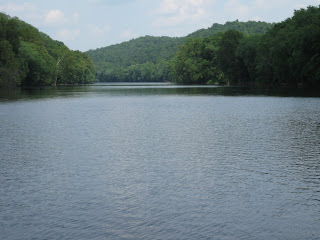 One is left to wonder what will be around the next curve in the road.
One is left to wonder what will be around the next curve in the road.Heavy. That’s the word I think of when I think Appalachian summer. Heavy as in the humidity of the air, the overhang of the forest canopy, the torrential downpours of rain, the low-hanging morning mist, the huge and daunting rocks of the mountains…even the heaviness of the fruits and vegetables bending stems and stalks of gardens in the hollers.
Since we lived in the depths of the Daniel Boone National Forest, summer brought on a verdant green canopy of foliage. Its depth obscured the mountain’s face and the homes hugging its edges. Allergy sufferers knew summer by the changing plant and tree leaves. Summer brought out the roto-tillers and garden seed. Many beautiful gardens filled hollers throughout the region, some immaculate and orderly; others a tangle of vegetable and weed stems. Preserving summer’s bounty was an art form for some, forgotten by others—thus instigating Red Bird’s efforts to reintroduce gardening skills to the region.
Summer humidity made us very thankful for air conditioning, and cranky when failed electricity or breakdowns made it go down. Heat came in relentless sweeps of 90-degree days that turned into 90 degree weeks, even months. Air temps often felt like 100+; everybody moved slowly and drank more; sweat poured and clothes stuck. We noticed something about living in a holler: the wind doesn’t blow there—it seems to skip above the ridges and misses the dips. We missed breezes. I often felt as if we were living in a terrarium.
Summer brought tourists to regions around the mountains, but not into the interior where we lived. Here children whiled away summer days playing in creeks, going to grandmas, and watching too much television or playing video games. The distance to parks, YMCAs, or organized activities meant a lot of idle time for youth. Red Bird did its part by providing a summer youth program and organized activities for young children through teens. Most families did not vacation, preferring to stay home during time off. Those who didn’t work to begin with, rarely left the mountains for lack of money or initiative. I found a love for travel very rare among mountain people.
Summer brought work teams en masse to Red Bird in order to participate in its Community Housing Improvement program. Beginning with trickles of teams in the spring and ending in trickles in the late fall, the housing program concentrates its projects on home repairs during the summer months. Work teams use school vacations to put youth energy to work on the many substandard homes in the Red Bird Valley. The forest with its vegetation and humidity, the mountains with their springs and dampness, take a toll on homes, especially on the trailer houses and substandard wood structures clinging to mountain edges. Many families are just now getting septic systems or adequate electricity; county safety and sanitation codes are not enforced in the region, making many homes dangerous and unsanitary for their occupants.
Summer brought community activities too, like cemetery reunions and bluegrass festivals. Cemetary services bring families together, and, yes, they are held at cemetaries. Women cook, men preach, children run around. Bluegrass festivals sometimes go on for days and feature many local groups, as well as national talent. The Osborn Brothers Bluegrass Festival is held each August in neighboring Hyden, featuring long days and nights of gospel, bluegrass, and country. I went to the festival and roasted in the summer sun, marveling at musicians performing energetically in long sleeves.
Yes, summer hangs heavy in the mountains. But even in the humid southern heat, flowers continue to bloom in succession even as hydrangea leaves wilt in daylight hours, water springs out of mountain rocks and the Kentucky River still flows toward the Ohio, the elk roam on mountain pastures, and people sit a spell on front porches. On lazy summer days, it’s good to find a shady spot, a fishing hole, a front porch…or an air-conditioned kitchen with iced tea flowing. Summer seemed to showcase the mountains in their richest and most verdant splendor, in massive coats of green leaves, grass and underbrush…a coat that soon enough would be shed for another season and only a promise of riches that would come again.











